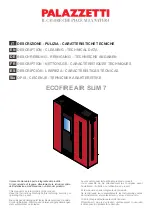
PLANNING YOUR INSTALLATION
PAGE 4
QUESTIONS TO ASK LOCAL BUILDING OFFICIAL
A correct installation is critical and imperative for reduc-
ing fire hazards and perilous conditions that can arise
when wood burning appliances are improperly installed.
The installer must follow all of the manufacturer’s in-
structions.
The installation of a wood burning appliance must con-
form to local codes and applicable state and federal
requirements. Familiarity with these requirements be-
fore installation is essential. Important considerations to
discuss with local building officials include:
1. Applicable codes (i.e. Uniform Mechanical Code,
State or Regional Codes)?
Electrical codes: Optional Blower Assemblies have
a flexible electrical cord that must be electrically
grounded per local codes or per electrical codes:
In USA, NEC, ANSI/NFPA 70-1987
In Canada, CSA C22.1
WARNING: ELECTRICAL GROUNDING INSTRUC-
TIONS: THIS APPLIANCE IS EQUIPPED WITH A
THREE-PRONG (GROUNDING) PLUG FOR YOUR
PROTECTION AGAINST SHOCK HAZARD AND
SHOULD BE PLUGGED DIRECTLY INTO A PROP-
ERLY GROUNDED THREE-PRONG RECEPTACLE.
DO NOT CUT OR REMOVE THE GROUNDING
PRONG FROM THIS PLUG.
DO NOT ROUTE POWER CORD UNDER OR IN
FRONT OF APPLIANCE.
2. Local
amendments?
3. Is a permit required - cost? (You may wish to con-
tact your insurance company to ask if they require
this).
4. Is outside combustion air required?
5. Rooms where the installation is not allowed?
SMOKE DETECTORS
Since there are always several potential sources of fire
in any home, we recommend installing smoke detec-
tors. If possible, install the smoke detector in a hallway
adjacent to the room (to reduce the possibility of occa-
sional false activation from the heat produced by the
stove). If your local code requires a smoke detector be
installed within the same room, you must follow the re-
quirements of your local code. Check with your local
building department for requirements in your area.
NOTE – This appliance is NOT approved for installa-
tion into a Manufactured (Mobile) Home in Canada
SELECTING A LOCATION
The design of your home and where you place your
stove will determine its value as a source of heat. A
wood stove depends primarily on air circulation (con-
vection) to disperse its heat, and therefore, a central
location is often best. There are other practical consid-
erations, which must be considered before a final selec-
tion of locations is made.
♦
Existing Chimneys
♦
Wood Storage
♦
Aesthetic Considerations
♦
Roof Design (Rafter Locations & Roof Pitch)
♦
Room Traffic
♦
Proximity to Combustibles
♦
Electrical Wiring
The installation of this stove will require some research.
Once your options are determined, consult with your
local building department who will be able to give you
the necessary installation requirements for your area (Is
a building permit required, Rooms where installation
may not be allowed, etc.).
WARNING: CHECK ALL LOCAL BUILDING AND
SAFETY CODES BEFORE INSTALLATION. THE IN-
STALLATION INSTRUCTIONS AND APPROPRIATE
CODE REQUIREMENTS MUST BE FOLLOWED EX-
ACTLY AND WITHOUT COMPROMISE. ALTERA-
TIONS TO THE STOVE ARE NOT ALLOWED. DO
NOT CONNECT THE STOVE TO A CHIMNEY SYS-
TEM SERVING ANOTHER STOVE, APPLIANCE, OR
ANY AIR DISTRIBUTION DUCT. FAILURE TO FOL-
LOW THESE INSTRUCTIONS WILL VOID THE
MANUFACTURER’S WARRANTY.
If you plan to vent your stove into an existing masonry
chimney, have it inspected by a local fire marshal or
qualified installer. Remember that a stove's perform-
ance is heavily influenced by the chimney and its loca-
tion on the roof. An oversized flue may not provide ef-
fective draw, and a flue liner may be required (see
Draft
Requirements
on page 9). Consult your dealer or quali-
fied installer before final selection is made.
This stove requires pre-installation work to be com-
pleted before installation can take place. This will in-
clude the preparation of the floor and appropriate
hearth pad for acceptance of outside air (if applicable),
and for modification for flue and chimney.
Summary of Contents for EARTHSTOVE 1400HT
Page 23: ...SAFETY LISTING LABEL PAGE 23 ...
Page 24: ...EPA LABEL PAGE 24 ...





































